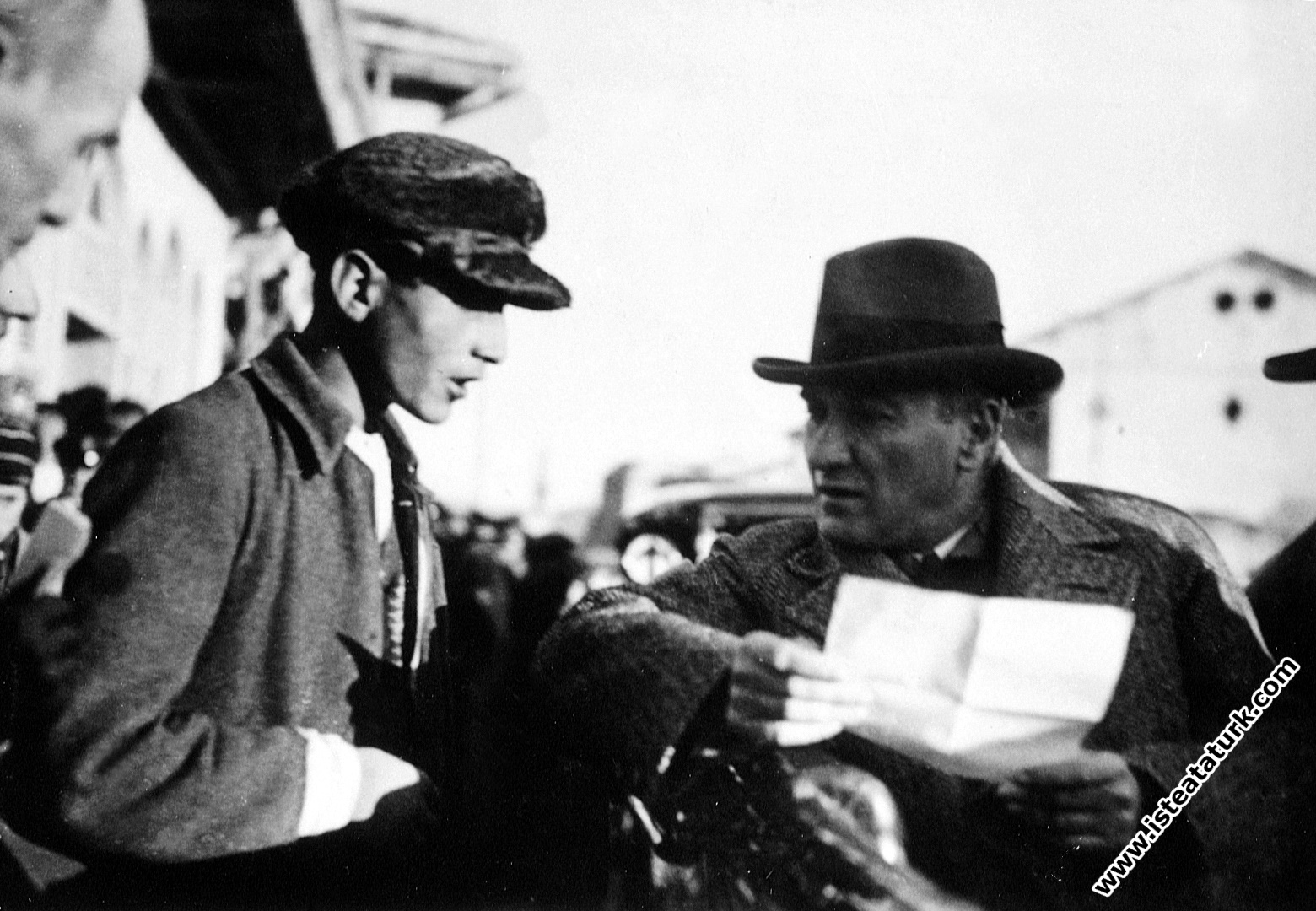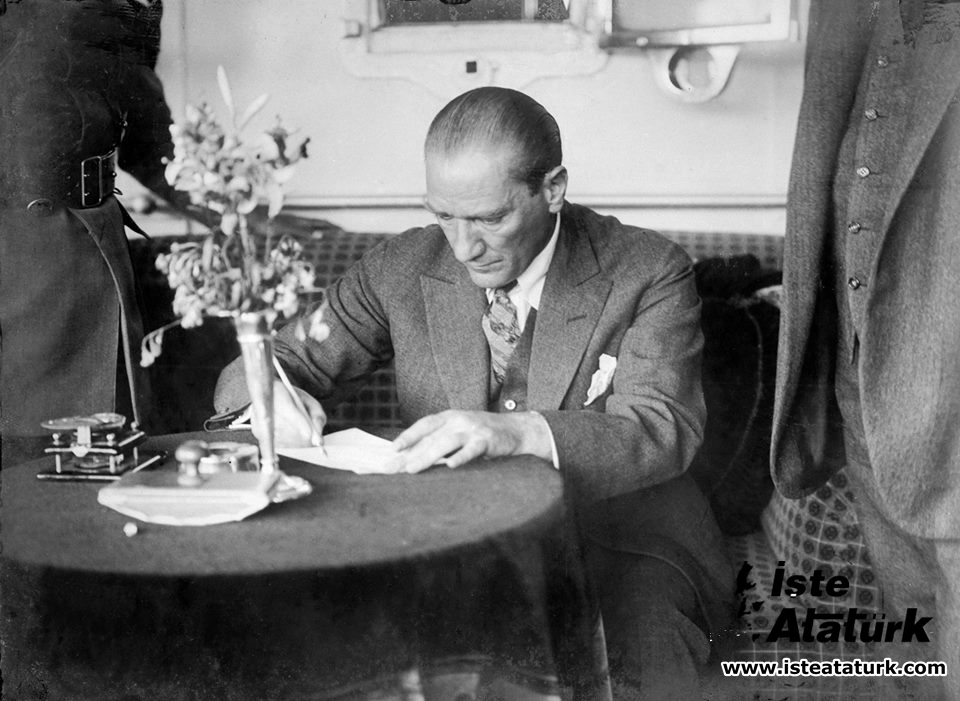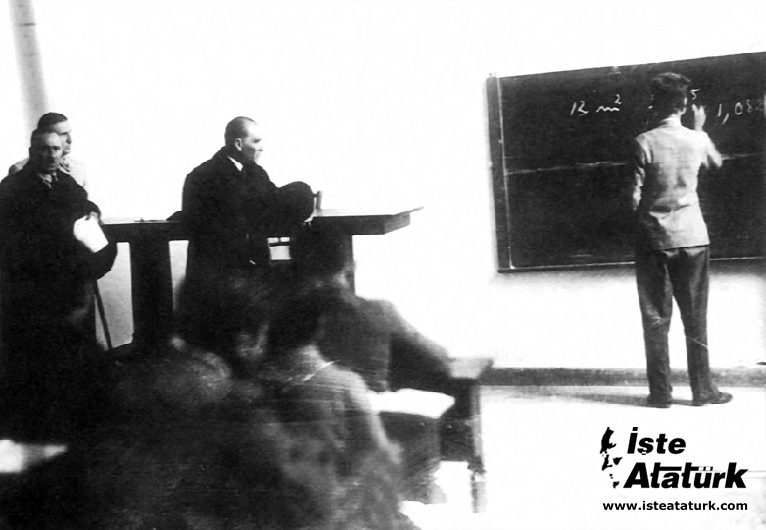
A Popular Leader from the People
Character Size
The life story of Mustafa Kemal is the story of a people fighting for independence. The life story that can tell Mustafa Kemal is the story of the people who can understand him best.
A PEOPLE'S LEADER FROM THE PEOPLE
The life story of Mustafa Kemal is the story of a people fighting for independence. Because Mustafa Kemal spent his whole life for the independence war of the Turkish people. For Mustafa Kemal, the people are all those who strive for an independent and free country. For this reason, no one among the people has any privilege over the other. The clergy, journalists, sect sheikhs, lawyers, soldiers and engineers among the Turkish people, for whom they fought for their independence, also took part in the first Turkish Grand National Assembly established in 1920. Mustafa Kemal never lived like an aristocratic citizen away from the public in any period of his life; He has always lived in the conditions of an ordinary citizen from the people, ate with people from the people, traveled and sang with the citizens. Wherever he went, the people greeted him miles before the city;
The life story of Mustafa Kemal Atatürk, which is often told in the form of an epic story with the addition of lyrical elements, is actually the story of an individual who lives with the power of his mind and intelligence and spends his whole life to achieve the goal identified with his personality. Exaggerating his features and actions is synonymous with disregarding his personal efforts and efforts. The life story that can tell Mustafa Kemal, who always sees himself in the same position as an individual standing in the middle of the mass of the people, is also the story of the people who can best understand him.
Mustafa Kemal looks at the Aegean Sea horizons from the shores of Izmir on September 10, 1922 and; He says, “I feel like I had a dream.”1 The dream that Mustafa Kemal says he saw is actually a reality like a dream he gave to the public. This story, which started at the point where he started out alone, gradually turned into a public avalanche, demolished huge continents, and planted seeds of a bright future among the lands he scattered.
Mustafa Kemal was 43 years old when he said he was dreaming by looking at the horizon. He is the commander-in-chief of an army and the head of a state in his middle age. He won a world war, established a new state, perhaps shook a people that was about to disappear from the face of the earth and brought it back to life.
Believing that people, states, armies and all other universal institutions are a basic raw material in their essence, Mustafa Kemal believes that no power can overcome an obstacle that the people cannot overcome, and that there is no obstacle that the people cannot overcome. Mustafa Kemal, who closely witnessed the most negative situations, captivity, humiliation and poverty that a people can fall into, states at the beginning of his speech that independence is the first condition for nations to live in prosperity and honor. has spent.
Without his people, he could not take a single step on his journey to independence and freedom. Without him, his people would have no meaning in thousands of years of history, because that people wouldn't exist anyway. The name of Mustafa Kemal Atatürk is the name of a giant truth that includes the name and volume of his people. The fact that he was commander-in-chief, a legendary victors or head of state has never changed the fact that he often lived economically as an individual from the lower strata of the people.
While he was in Sivas during the National Struggle journey, his friend, who was dealing with food business, stood in front of him and said to him; He says, “Pasha, we have run out of money, grocers and butchers do not give on credit anymore.” On the way from Sivas to Ankara, the delegation and those accompanying them could only buy 20 eggs, 1 ounce of cheese and 20 bread with their pockets. Two of the three junk cars carrying passengers had tires filled with rags. This image is of a people preparing for war.
For Mustafa Kemal, the people are everyone who strives for an independent and free nation and homeland. For this reason, no one among the people has any privilege over the other. In April 1920, Mustafa Kemal personally greeted those who came from all over Anatolia to join the Kuvayi Milliye at the Ankara station. Because they are members of the public who share the same cause and are his most loyal supporters. There are individuals from all walks of life among the 414-person staff of the First Grand National Assembly of Turkey. 8 of them were sect sheikhs, 10 tribal chiefs, 61 clergy, 6 journalists, 29 lawyers, 51 soldiers, 2 engineers, 15 physicians, 46 farmers, 36 119 of them are merchants, 119 of them are civil servants and retired.3
Mustafa Kemal, wandering around the lands where his people lived for years, observing people, witnessing their suffering and understanding them as if he understands himself, has also found the most effective methods of being with the people, calling out to them, explaining his purpose to them and bringing the people to his side. When he was going to give a message to the public, he generally preferred to meet with the public in places where the public could be found heavily, where he could clearly understand what was said, and where the people often came and went in daily life. For this reason, he often spoke in mosques during the National Struggle, where he organized the Anatolian people against the invaders. In the speech he gave at the Paşa Mosque in Balıkesir on February 7, 1923, he explained what the mosques meant to the people and what kind of function they had. Mosques are not places where people sleep and get up, regardless of face to face. He emphasized that religion and world affairs are places where they are discussed mutually. He said that mosques are the houses of both God and the people.4
Mustafa Kemal, who constantly lives in a mass of people that covers the whole earth in his heart and thought, preferred to be alone in his private life and to build the future of his people in this loneliness. It is not possible in any other environment to think and shape the strategies of a war that corresponds to the most brutal wars in history and the structure of a new state, as well as a republic. Since his childhood, Mustafa Kemal's body cannot bear to live in a house where there are other people, even his mother and brother. Therefore, when he returns to Istanbul from Syria, he does not want to settle in the house numbered 76 in Akaretler, where his mother and brother live.5 He wants to develop his plans and strategies regarding the independence and freedom of his people within his own independence.
The roots of the core of the peaceful country that Mustafa Kemal thought and shaped for the future of his people go back to his childhood, Thessaloniki. His new country is built on a wealth of experiences and accumulations that fill a lifetime.
In the last quarter of the nineteenth century, Thessaloniki was the largest provincial center and port city of Ottoman Europe at that time. Like all Ottoman cities, Muslim and Christian quarters are separate from each other in Thessaloniki. Thessaloniki is also the most important center in the east for Jews.
Again, as in all Ottoman cities, Muslim quarters in Thessaloniki have a more backward, dilapidated and neglected appearance than others. In areas where Muslims live, the neighborhood has full and definite control over the people of the neighborhood. An invisible hierarchy and an informal discipline are practiced in the neighborhoods.6 This traditional control also gives Mustafa Kemal the first impulses to embark on a determined journey of freedom.
As in all eastern cities, life in the city ends early for the Muslim people of Thessaloniki. Men would return from work before the sun went down, and women would prepare themselves for men. However, the excitement of the early day, when the setting day accustomed people, never gripped Mustafa Kemal. It was never early evening for him. Mustafa Kemal always read, observed and thought for endless days.
Mustafa Kemal's mother Zübeyde Hanım and his father Ali Rıza Efendi were both commoners. Like all Turkish families at that time, their families cannot be remembered for one or two generations. Çayağzı, where Ali Rıza Efendi worked as a customs guard, was at the foot of Olympos, the sacred mountain of Greek mythology. However, Mustafa Kemal probably did not listen to any of the legends in Greek mythology in his childhood and grew up with the stories of his own people.
The years when Mustafa Kemal entered the military school with his own decision and a disaster against his mother; On the map, theoretically, the Ottoman state stretched from Bosnia to Basra, from Mount Ararat to Central Africa, but the rule of administration did not remain, the army collapsed, the mountains and roads fell into the hands of bandits, the treasury remained empty, the state went bankrupt, the capitulations, the state was completely destroyed. These were the years when he dominated the spheres of sovereignty.
In the years when he moved from Thessaloniki to the monastery school, there was a fusion of minorities. Minorities wanted independence. While Mustafa Kemal was in the Manastır Military High School, the Turkish-Greek war of 1897 broke out. The repercussions of the war in Manastır aroused excitement in Mustafa Kemal as well, and by participating in the debates, he improved his rhetoric and interest in literature.
During his freedom journey that started from Samsun on May 19, 1919, Mustafa Kemal got out of the Mercedes-Benz car that he rode from time to time and interviewed the people and the farmers and asked questions.7 These interviews constitute the first data of the strategies of the liberation war. His first aim during his journey to national independence was to win over the people. Because the national independence movement will be a popular movement. For this reason, he primarily tries to convince the prominent people such as ulema, sect sheikhs and notables to believe in his own purpose.
He calls on the people of Amasya to rise up against both the Istanbul government and the invaders. Because the conditions of that day demand it. Thus, the first popular resistance of the National Struggle begins in Amasya. The first principles document of the resistance is also written under the name of Amasya Resolutions.8
One of the two aspects of the Kuvayi Milliye movement is the idea of organization, and the other is that it is a popular movement. Mustafa Kemal expressed this idea for the first time in the declaration of the Erzurum Congress: "It is essential to make the national force and the national authority dominate." Mustafa Kemal's goal is only the sovereignty of the people. The army made up of the people and the gangs, which are groups of the armed people, are very different from each other. For this reason, Mustafa Kemal tried to organize, organize and discipline the people and try to obtain an army that could resist the colonialists. Although he learned that he was dismissed from the army while passing from Tokat to Sivas, his power to grasp the people was enough for the people to take to the roads to defend the last rock of the country with sandals.
Mustafa Kemal's communication with the public and the common language he used with them are so strong that; The density of communication processes and the multiplicity of methods surprise and alarm even the invaders. British captain Hurst, who served in Samsun, said the following in the report he gave about Mustafa Kemal on 12 June 1919: “The telegraphic communication he established with the surrounding towns and beyond was so large that he almost monopolized the telegraph office.9
Mustafa Kemal, who could grasp the people, of which he was a part, from the most sensitive point, became a legend among the people as well as being a people's leader with his own efforts, and was greeted with enthusiasm, sincerity and magnificent ceremonies by the people wherever he went. On his way to Ankara after the Sivas Congress, miles before Ankara, he was greeted by the naive groups of people.
Mustafa Kemal was of medium height, with slender hands and feet, and a thin voice. However, despite these miniature features, he always had a charisma that stood out in every situation, attracting attention, and easily impressing those around him. be explained with credible communication processes.
After choosing Ankara as a base for independence and the republic and establishing its headquarters, Ankara becomes the center of attention of all Anatolia and foreign states. Mustafa Kemal, who was welcomed by the people quite outside the city when he entered Ankara, was greeted by an enthusiastic crowd while entering Erzurum during his independence journey in 1919. Mustafa Kemal, whose confidence in his people was strengthened by the reflection of the enthusiasm boiling from his people in his own heart, decided to resign from the army when he left Erzurum and to fight against both the Istanbul government and the invaders with his people.
If the people are walking, he has walked, if the people are standing, he is standing, if the people are suffering, he is suffering, if the people are laughing, he is laughing too. It came to such a point that every action of the people and the actions of Mustafa Kemal became a single action. Not only while preparing for war, for the republic, for revolutions, but also while working in the field, dreaming and eating, the actions of the people and the people are integrated. Mustafa Kemal never ate alone, while sitting down to dinner, he mostly sat with friends or members of the public, stayed at the table for about two hours chatting, allowed those around him to take off their jackets in hot climates, and asked the attendants to eat without rushing without alarming them.11
The Republic is the joint product of the people and Mustafa Kemal. However, the republic requires more effort and methods to carry it to eternity than the effort spent for its establishment. Mustafa Kemal is also working to create the infrastructure for this. Believing that one of the biggest steps in carrying the republic to eternity by reaching the level of contemporary civilization is public enlightenment, Mustafa Kemal, thinking that a nation can rise and develop by writing and speaking its own language with the most appropriate alphabet, set up a committee in June 1928 and starts studies to determine how the Latin alphabet can be used in accordance with Turkish phonetics. Mustafa Kemal wants everyone in his country, without exception, to be literate. In a speech he gave in Istanbul Sarayburnu; teaching new Turkish letters to every citizen, woman, man, porter and boatman,
Mustafa Kemal believes that no society or country can progress with primitive beliefs and practices and superstitions. For this reason, the subject that angered him the most was the popular superstitions, most of which were attributed to religion. Maybe not religion, but superstitions based on religion are the enemies he primarily fights. In his speech in Kastamonu, he emphasized that nations that try to walk with primitive superstitions are doomed to perish or become captive and humiliated.13
While Mustafa Kemal was paving the way for civilization that will extend to eternity in the new republic shining with sparkles, he wanted to place the principles, products and beauties of fine arts at the most important stages and the most valuable points of this path. "Whose sculptures should be made?" opened by Dünya newspaper in 1935. Mustafa Kemal's view for the competition is very clear: historical people who have served his people. For this reason, he first orders the Turkish Historical Society to build the statue of Mimar Sinan.14
1 Sevket Sureyya Aydemir, One Man, Vol. 3, Remzi Bookstore, Istanbul 1998, p. 131.
2 Kemal Atatürk, Speech, National Education Press, Ankara 1987, p. 13.
3 Feridun Ergin, K.Atatürk, Yaşar Education and Culture Foundation, Istanbul 1978, p. 102.
4 Aydemir, supra, p. 76.
5 Falih Rıfkı Atay, Memories of Atatürk, T. İş Bankası Pub. Ankara 1965, p. 34.
6 Aydemir, supra, p. 21.
7 Aydemir, supra, p. 22.
8 Aydemir, supra, C. 3, p. 38.
9 Andrew Mango, Atatürk, Morning Books, Istanbul 1999, p. 222.
10 Vomık Volkan - Norman Itzkowitz, Immortal Atatürk, Baglim Publications, Istanbul 1998, p. 208.
11 Şükrü Tezer, Atatürk's Diary, TTK Publication, Ankara 1972, p. 115.
12 Muzaffer Erendil, Atatürk with Interesting Events and Anecdotes, GNKUR Publication, Ankara 1998, p. 72.
13 Volkan - Itzkowitz, ibid, p. 341.
14 Afet Inan, Memories and Documents About Ataturk, T. Isbank Publication, Ankara 1984, p. 183.
Assoc. Dr. Sedat Cereci*
*Faculty Member of Yuzuncu Yıl University
Source: ATATÜRK ARAŞTIRMA MERKEZİ DERGİSİ, Sayı 52, Cilt: XVIII, Mart 2002




